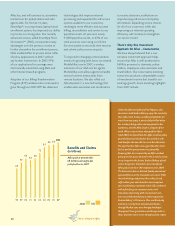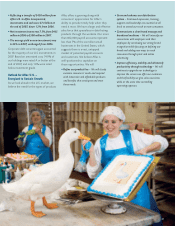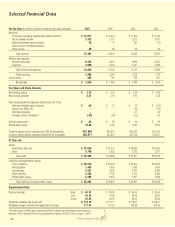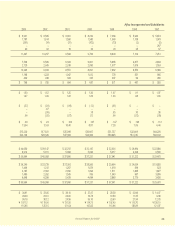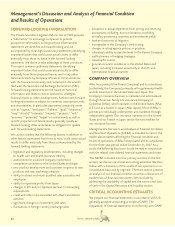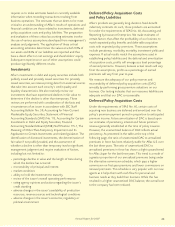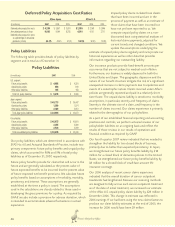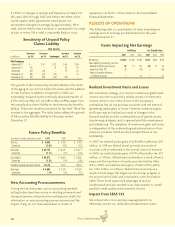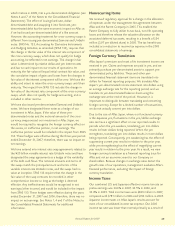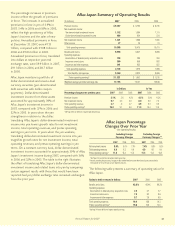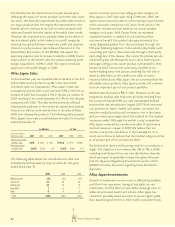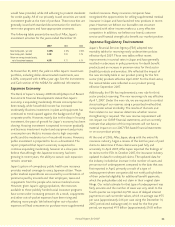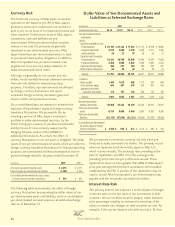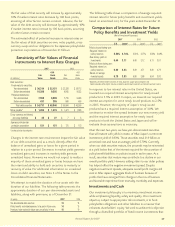Aflac 2007 Annual Report Download - page 31
Download and view the complete annual report
Please find page 31 of the 2007 Aflac annual report below. You can navigate through the pages in the report by either clicking on the pages listed below, or by using the keyword search tool below to find specific information within the annual report.
In 2006, our review also indicated that our policyholder
liabilities were fairly stated in the aggregate; however, the
components of policyholder liabilities (the unpaid policy
claims liability and the future policy benefits liability) needed
to be refined. As a result of our review, we took the actions
described below.
During the fourth quarter of 2006, we transferred $170 million
of the Aflac U.S. unpaid policy claims liability to the future
policy benefits liability for our accident/disability, short-term
disability, dental and specified health event lines of business.
For the accident/disability line of business, a very small
portion of the benefits in one of our policy forms required a
future policy benefits liability to be accumulated. This amount
was insignificant to our financial position in any year. However,
to provide for this obligation, we approximated this liability
amount as part of the unpaid policy claims liability. We
determined that it was appropriate to modify our calculation
method to determine the future policy benefits liability for
that benefit separately from our unpaid policy claims liability
and to move this liability of $25 million into the future policy
benefits liability.
For one of our short-term disability policy forms, we
determined that a selection factor assumption that should
have applied to the future claim costs was not reflected in the
calculation of the future policy benefits liability. We began
using the calculation including the selection factor in the
fourth quarter of 2006. We use a total liability approach to
determine the unpaid policy claims liability for that line of
business. For this reason, the underestimated amount of the
future policy benefits liability, approximately $50 million, was
accounted for in prior periods in the unpaid policy claims
liability. As a result, we transferred $50 million from the
unpaid policy claims liability into the future policy benefits
liability for that line of business.
For our dental and specified health event product lines, both
of which are recently introduced product lines with limited
actual claims experience, we refined the reserving
methodology. For this reason, we had determined our policy
liabilities for these two product lines using a total liability
approach. This approach utilized expectations of claims costs
and impact of underwriting based largely on the product
pricing assumptions. As we developed experience on the
dental and specified health event product lines, we modified
our assumptions as to the impact of underwriting selection.
Our experience has shown that the underwriting selection
impact is greater than we had anticipated in our original
pricing. In addition, for our dental plan, we also modified our
assumption of the impact of various benefit waiting periods
for that plan to reflect the larger-than-anticipated impact of
the waiting periods. Both of these changes in assumptions
resulted in 2006 claims being lower than anticipated in the
original pricing assumptions for these two products. Thus, our
unpaid claims liability was lower than we originally estimated.
However, our analysis also showed that the future claim cost
curve would be steeper than we originally anticipated. Thus,
we expected more future claims than we previously estimated
and increased our liability for future policy benefits
accordingly. For this reason, in the fourth quarter of 2006, we
modified our methodology to use a combination of claim cost
expectations and claim completion factors to calculate the
unpaid policy claims liability for these two product lines. As a
result, the modification in methodology resulted in a transfer
from the unpaid policy claims liability of approximately $95
million to the future policy benefits liability.
Also during the fourth quarter of 2006, we transferred $85
million from Aflac Japan’s unpaid policy claims liability to its
future policy benefits liability. This transfer primarily related to
a continued decline in current period claims caused by
changes to health care delivery in Japan and had no effect on
net earnings. Our 2006 claims review indicated that we have
experienced a continued decline in the average number of in-
hospital days associated with cancer treatment periods in
Japan. We believe the average number of days per hospital
visit declined primarily due to changes in financial incentives
provided to hospitals by the government-sponsored health
care system in Japan to shorten the average hospital stay.
However, our claims statistics also indicated that the declines
in the average number of days per hospitalization have
generally been offset by an increase in the frequency of future
hospitalizations associated with the treatment of cancer. As a
result, we reflected the increased number of future
hospitalizations per claimant in our future policy benefit
liability. More hospitalizations per claimant will result in a
larger amount of expected future claims and an increase in
our liability for future policy benefits. Meanwhile, we are
paying less for current period claims, and therefore have a
smaller unpaid claims liability.
In computing the estimate of unpaid policy claims, we
consider many factors, including the benefits and amounts
available under the policy; the volume and demographics of
the policies exposed to claims; and internal business practices,
such as incurred date assignment and current claim
administrative practices. We monitor these conditions closely
and make adjustments to the liability as actual experience
emerges. Claim levels are generally stable from period to
period; however, fluctuations in claim levels may occur. In
calculating the unpaid policy claim liability, we do not calculate
a range of estimates. The following table shows the expected
sensitivity of the unpaid policy claims liability as of December
27
Annual Report for 2007





